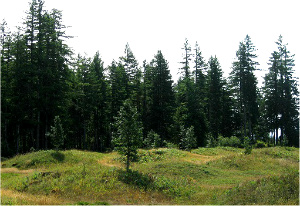For an overall perspective of the Mima Mounds prairie, most folks head straight for the top of the observation tower located at the edge of the preserve. But to get a real sense of the otherworldly landscape, it’s best to hike the two mile Prairie Loop Trail that winds through (and sometimes over) the grassy mounds. Some are covered with huckleberry bushes or lichen and white moss. Others are crowned with a single Garry oak tree. But it’s the uniformity of the mounds that is most striking. Roughly 6 feet tall and 30 feet in diameter, they’re all the same–like rows of bubbles in a sheet of bubble wrap. No wonder Charles Wilkes thought he had stumbled upon an ancient Indian burial ground. They’re such an “unnatural” natural phenomenon.
Who was Captain Charles Wilkes? He was an American naval officer who came across the Mima Mounds while exploring parts of the Pacific NW in 1841. Can you imagine his excitement when he first caught sight of this unique forest-locked prairie? The swath of grassland spread out before him was dotted with hundreds of earthen mounds. Mounds so uniform in size and shape, what else could they be but tombs? Burial mounds built by the natives! He ordered his men to tunnel into one, no doubt hoping for funerary treasure, but all they found was . . . gravel.
Though no priceless Native American artifacts were ever found here, the Mima (pronounced MY-ma) Mounds are a treasure in themselves. No other natural site is shrouded in such mystery.
Why are they here? How were they made?
Since Captain Wilkes’ discovery, a number of theories have surfaced concerning the origin of the Mima Mounds. Some believe they were created by the freezing and thawing of glaciers during the last Ice Age. Others think they are the results of earthquakes, volcanic explosions, or maybe just simple erosion. One theorist even suggests that the mounds were made by pocket gophers who pushed the earth up and out as they burrowed underground. (like the moles in your front yard)
I think native tribes had the best explanation. The people of the Upper Chehalis tribe believed that the Mima Mounds were left behind after a great flood subsided.
Regardless of how they were created, this 637-acre natural preserve is truly one of nature’s oddities. A short path leads through a thick stand of Douglas Fir trees to the edge of the prairie. A half mile paved trail loops around some of the Mima Mounds and back to the parking lot. The two mile, soft surface, Prairie Loop Trail that we followed branches off from the paved path shortly after passing the observation tower. The longer route was well worth the extra time we spent at the preserve.
The Mima Mounds Natural Preserve is located about 17 miles southwest of Olympia, WA. From I-5, take Exit 95 and turn west on Highway 121 toward Littlerock. In Littlerock, continue west onto 128th Avenue. Travel 0.8 mile to where 128th Avenue ends in a “T” at the top of the hill. Turn right onto Waddell Creek Road and travel about a mile. Entrance to the preserve is on the left.
A Washington State Discover Pass is required to park at this site. And because the ecosystem is so fragile, no dogs are allowed inside the Mima Mounds Preserve.
Special Note: When we came late in August, the Mima Mounds Natural Preserve was a sun-baked prairie. But in spring and early summer, that same prairie explodes with color as the grassy mounds are covered with wildflowers!

